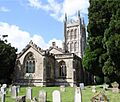St Andrew's Church, Mells facts for kids
Quick facts for kids Church of St Andrew, Mells |
|
|---|---|

Church of St Andrew, Mells
|
|
| 51°14′30.94″N 2°23′25.89″W / 51.2419278°N 2.3905250°W | |
| Denomination | Church of England |
| Churchmanship | Broad Church |
| History | |
| Dedication | St. Andrew |
| Administration | |
| Parish | Mells with Vobster |
| Deanery | Frome |
| Archdeaconry | Wells |
| Diocese | Bath and Wells |
| Province | Canterbury |
St Andrew's Church is a beautiful old church in the village of Mells, Somerset, England. It's part of the Church of England and is considered a very important historic building. This means it's protected because of its special history and design.
Contents
History of St Andrew's Church
This church was mostly built in the late 1400s. It has a special style called 'Perpendicular Gothic,' which means it has tall, straight lines and big windows. Even though it was fixed up in the mid-1800s, a church has stood on this spot for hundreds of years. Back in 1292, it belonged to Glastonbury Abbey, a very famous monastery. The church also has strong connections to important local families, like the Asquith family and the Horner family, who lived at Mells Manor.
Famous People Buried at Mells Church
Many interesting people are buried here or have special memorials inside the church. Some of them include:
- Siegfried Sassoon: A famous poet.
- Ronald Knox: A well-known priest.
- Sir Maurice Bonham Carter: A politician.
- George A. Birmingham: A novelist, whose real name was James Owen Hannay.
- Katharine Asquith: The wife of Raymond Asquith.
Special Memorials and Statues
The church also has several unique memorials:
- A statue of Edward Horner on horseback, made by Sir Alfred Munnings. Edward Horner was a soldier who died in a battle in 1917. This statue was so good that it led to the artist making another famous statue of a racehorse.
- A bronze wreath designed by Sir Edwin Lutyens, with special writing by Eric Gill, in memory of Raymond Asquith. Sir Edwin Lutyens also designed the Mells War Memorial in the village.
- A bronze plaque for Captain Stanes Geoffrey Bates, a soldier who died in the First World War.
- A white plaque from 1886 by Edward Burne-Jones for Laura Lyttelton. A gilded copy of this memorial is in the Victoria and Albert Museum.
Church Architecture and Design
The inside of the church is beautiful. It has a special screen behind the altar called a reredos, made of white marble. The altar itself is made of different colored marbles. There's also a Norman font, which is a very old basin used for baptisms. You can also see several stained glass windows that were made around 1850. Other cool features include:
- A stained-glass window by William Nicholson.
- A tapestry made by Lady Horner, based on a design by Burne-Jones.
- A stone tablet listing the names of villagers who died in the two World Wars.
The church is officially a Grade I listed building, which means it's one of the most important historic buildings in England.
Organ, Bells, and Clock
The church has a large pipe organ with two keyboards, built in 1880. You can find more details about this organ on the National Pipe Organ Register.
The church tower was built around 1446. It has a clock from the 1600s and a set of eight bells that are used for change ringing. The oldest bell is from 1716. Two of the bells were made by the Rudhall family, famous bell founders from Gloucester. Three more bells were cast by the Bilbie family, another well-known group of bell makers. The remaining three bells were made in 1869 by Mears & Stainbank. There's also a small sanctus bell in the roof of the chancel, which is very old, dating back to about 1325, and is listed as historically important.
Gallery
-
Grave of Siegfried Sassoon
-
Memorial to Raymond Asquith
-
Grave of Ronald Knox
See also
- List of ecclesiastical parishes in the Diocese of Bath and Wells






